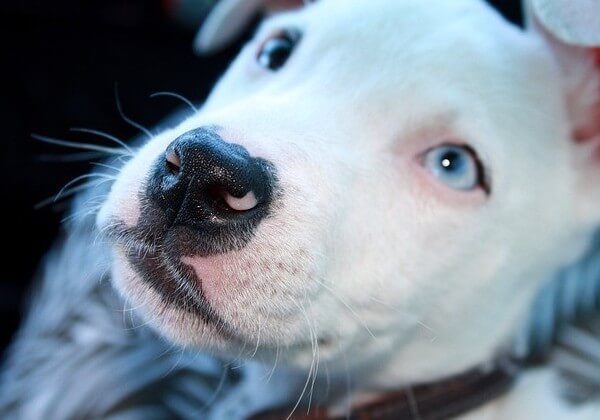
Many people believe that White Pitbulls are rare, but that’s not exactly true. There are other rare color variants of the American Pit Bull terrier such as the Blue Nose Pitbull. Regardless, it’s pretty rare to see a White Pitbull and you’ve landed on this article because you are interested in this dog and want to learn more.
In this guide, we will discuss everything you need to know about White Pitbulls – from appearance, history, size, weight, and temperament, to health problems and nutrition. Without further ado, let’s get started!
Table of Contents
White Pitbulls: What is a White Pitbull?

A White Pitbull is one whose base coat color and overall appearance are white. The term “White Pitbull” can refer to any member of the pit bull family, but it is usually associated with the American Pit Bull terrier. White is a natural color for Pitbulls, but it is pretty rare compared to other coat colors.
White Pitbulls Appearance

1. Color
As their name suggests, White Pitbulls are almost entirely white. They may have spots or patches of another color here and there, but the dominant coloring is white.
2. Coat
Like all Pitbulls, a White Pitbull’s coat is short and smooth. The thin fur accentuates their ripped physique, giving them an athletic appearance. The White Pitbulls’ coats are shiny, but not as much as dark coats.
3. Eyes
White Pitbulls have brown or hazel eyes. If a White Pitbull has light blue, red, or pink eyes, it is an albino and not a standard White Pitbull.
4. Nose
White Pitbulls have dark-colored noses. They may be black, blue, brown, or red, but never pink. Pink or unpigmented noses are seen as substandard.
5. Build
White Pitbulls have ripped bodies that add to their tough persona. They are broad-chested and have a wide and stable stance. Their thick muscular legs give them their agility and speed.
6. Pattern
White Pitbulls are usually solid white, but they may also have spots or patches of another color. Some White Pitbulls have cow-like black or brown patches; they are aptly called Moo Moo Pitbulls.
7. Tail
White Pitbulls have a medium-length tail that is thick at the base and tapers off towards the tip.
8. Size
White Pitbulls are 17 to 21 inches high at the shoulder, putting them among medium-large canines. Female White Pitbulls are generally 1 to 2 inches shorter than male White Pitbulls.
White Pitbulls: Color Genetics Explained

Pitbulls have two pigments that determine the color of their skin. Both these pigments are forms of melanin. Eumelanin determines the eye and nose color, whereas phaeomelanin determines the coat color.
Certain genes can tinker with these pigments, diluting them and resulting in unique colors and patterns on the dog’s nose, eyes, and coat.
For a Pitbull to be white, it needs to carry the S gene. The S gene has four types:
- S.
- si.
- sp.
- sw.
Each alters the color of the phaeomelanin pigment. S causes a solid white coat, whereas the si, sp, and sw cause different types of white spotting.
Fun Fact: Because White Pitbulls have short coats, many people believe that they are hypoallergenic. But are they? Check out Are Pitbulls Hypoallergenic? to find out!
Leucism vs Albinism
The two terms are often confused because of their apparent similarities. While both of these are genetic conditions that result from reduced pigmentation, they have visible differences.
Leucism is when a Pitbull has minimal pigmentation, resulting in a pure or partially white coat. Unlike albino dogs, their eyes are always normal-colored. That’s because this condition affects phaeomelanin, not eumelanin.
Albinism is when a Pitbull is entirely void of pigmentation. Unlike leucism, albinism is never partial, and every part of the Pitbull’s body is white or light pink. That’s because albinism affects both phaeomelanin and eumelanin.
The lack of pigmentation in albinos makes them highly susceptible to blindness and various other diseases. Leucistic Pitbulls, however, are safe from most of those conditions.
Difference between White Pitbulls and regular Pitbulls

1. Coat color
The most obvious difference is the Pitbull’s coat color. White Pitbulls, as the name suggests, are entirely or predominantly white. Regular Pitbulls come in shades of black and fawn.
2. Sensitive skin
White Pitbulls have more sensitive skins due to the lack of melanin in their bodies. Melanin protects the skin from the harmful UV rays of the sun. A lack of it means the Pitbull is more susceptible to sunburns and skin cancer.
3. Price
White is a rare and sought-after color in Pitbull, making it significantly costlier. White Pitbulls cost 2 to 3 times more than dark-colored Pitbulls.
White female Pitbull vs White male Pitbull: What’s the difference?

1. Size
Male White Pitbulls are about 17 to 21 inches high at the shoulder. White female Pitbulls tend to be about 2 inches shorter than their male counterparts; however, they usually have longer bodies.
2. Weight
Due to their bigger bodies and thicker frames, White male Pitbulls are heavier than females. The average white male Pitbull weighs 35 to 65 pounds, whereas female White Pitbulls weigh about 30 to 50 pounds.
3. Temperament
While all Pitbulls are considered even-tempered, male White Pitbulls are considerably more aggressive towards other dogs. Male hormones are to blame here, and neutering your male White Pitbull will make them calmer.
4. Behavior
Male White Pitbulls tend to mark their territories through urine and leave smelly stains. Female White Pitbulls don’t do that but go through heat cycles characterized by red secretions from their behinds. Both behaviors are absent among spayed and neutered White Pitbulls.
5. Breeding age
The suitable breeding age for a White male Pitbull is 12 to 15 months, whereas a female White Pitbull is about 2 years. Although female White Pitbulls mature much earlier, the minimum age limit of 2 years ensures that the female White Pitbull is in peak health before her first pregnancy.
6. Head
Female White Pitbulls have a slightly narrower head with eyes comparatively further apart. They also have tighter lips, whereas the lips of the White male Pitbulls are somewhat loose.
Are White Pitbulls Rare?
Although white color occurs naturally in Pitbulls, it isn’t as common as black, fawn, brown, and brindle colors. White is among the more sought-after coats for Pitbull enthusiasts, and some breeders take shady measures to profit off its exclusivity.
Are White Pitbulls Deaf?
No, White Pitbulls are not deaf. If you have a regular White Pitbull and not an albino or leucistic one, it will likely have perfect hearing. There is an impression that White Pitbulls are more prone to deafness; however, there is no proof behind that.
On the other hand, albino and leucistic Pitbulls are highly susceptible to deafness. The lack of melanin in their ears disturbs their proper functioning. These Pitbulls can be born deaf or may develop deafness later on.
Are White Pitbulls More Aggressive?
Mentally, White Pitbulls are no different from any other Pitbull. These dogs get along fine with people but act aggressively towards other animals. Training can help them get along with other dogs, but smaller pets are not safe around them.
A Pitbull’s behavior boils down to how it is treated. If a White Pitbull wasn’t raised properly with respect, he will develop personality flaws, causing it to behave unpredictably and aggressively.
White Pitbulls Temperament and Personality
There is no correlation between coat color and temperament, and White Pitbulls show the same patient and calm character as other Pitbulls. The American Temperament Test Society has tested them to have a better disposition than many other popular pet dog breeds.
White Pitbulls are kind, gentle, intelligent, caring, and loving dogs. They are devoted to their owners and would do anything for their approval.
Are White Pitbulls good family dogs?
White Pitbulls make superb nannies. They have the composure, intelligence, and energy to make them ideal family dogs. If you have energetic children who play all day, a White Pitbull will have no trouble keeping up with them. You can also rest easy knowing your children are safe with this dog because a trained White Pitbull would never attack humans.
White Pitbulls Exercise
White Pitbulls are energetic, tenacious, and active dogs that require at least 60 minutes of daily exercise. Simply jogging for an hour or so won’t satisfy them; you also need to have some fun games for their mental stimulation.
If your White Pitbull doesn’t get to release its pent-up energy every day, its behavior can get destructive. Expect shoes, clothes, furniture, and anything the Pitbull can put its jaws around to be chewed up beyond recovery. Other than that, a sedentary lifestyle can lead to obesity, and that brings a whole slew of health issues.
White Pitbulls Training
- Prioritize socialization training so your White Pitbull doesn’t act on its aggressive impulses around another dog.
- Training is easiest during puppyhood as pups are enthusiastic, flexible, and curious.
- Training should cover etiquette around people. Pitbulls can be jumpy around humans because they are always excited to see and meet new people, which may scare visitors.
- Use tasty treats as rewards. A reward method is more effective with Pitbulls as these muscular dogs don’t respond well to punishments.
- Change your training environment often. Your White Pitbull should learn to obey you in all conditions, not just in a specific setting.
White Pitbulls Grooming
Although grooming Pitbulls is easy, White Pitbulls are slightly more high-maintenance than other Pitbulls. Their white coat gets dirty easily, and they would need more frequent baths than a dark-colored Pitbull.
Note that White Pitbulls have sensitive skins, and hot water and soap would strip their coat of natural oils, giving them dry and itchy skin. So keep hot baths to a minimum and use mild shampoos or soaps to protect their skin.
Pitbulls shed all year round, but they have short fur that doesn’t make much of a mess. Brushing them twice a week will keep shedding under control and the fur dirt-free. Thanks to the shedding, White Pitbulls don’t require haircuts.
White Pitbulls Nutrition and Diet
White Pitbulls need lean protein to nourish their muscular bodies and plenty of healthy calories to fuel their active lifestyle. The best sources of protein are beef, chicken, and turkey. Feed pork in moderation as it is high in fats. The same goes for mutton.
Your White Pitbull can meet most of its dietary needs from meat, but feeding him or her fruit or vegetable can give it essential vitamins and carbohydrates. Apples, bananas, coconut, pumpkin, sweet potatoes, and peanut butter are excellent non-meat dog foods that do wonders for your White Pitbull’s health.
If you prefer store-bought dog food, make sure it is high in meat and low in grains. Dry foods or kibble is best for your Pitbull due to its low-fat content. Depending on your White Pitbull’s age, health, and size, give them 1.5 to 2.5 cups of kibble a day. Split it into two or three meals to keep your pooch fed throughout the day.
White Pitbull Health Problems
1. Skin sensitivity
All Pitbulls have sensitive skins and are prone to several skin conditions. White Pitbulls suffer from the same sensitivity issue as their non-white variants. On top of that, White Pitbulls have low melanin and are more sensitive to intense sunlight. You should keep your White Pitbull safe from the mid-day sun and take extra care of their skin.
2. Hip dysplasia
Hip dysplasia is the gradual deformation of the hip joints. It progresses with age and is prevalent among senior Pitbulls. If you keep your White Pitbull out of the sun to avoid skin burn, it may develop a vitamin D deficiency, leading to bone weakness. Obesity also contributes to hip dysplasia.
3. Cataracts
Cataracts are prevalent among Pitbulls of all colors—including white. Cataracts cause the dog’s lens to turn cloudy or completely opaque. White Pitbulls with dark eyes are at a higher risk of developing cataracts.
4. Deafness
There is no correlation between deafness and coat color. However, White Pitbulls that have leucism or albinism are likely to inherit or develop deafness. The lack of pigmentation in such Pitbulls sometimes extends to their ears, messing with their hearing function and causing the dog to be born with deafness or develop it later in life.
5. Blindness
If your White Pitbull has light-colored eyes, they are at a higher risk of developing blindness. Blue, pink, and red aren’t as effective as brown or black at protecting the eyes from bright light, and a light-eyed White Pitbull runs a higher risk of blindness.
Can White Pitbulls Have Blue Eyes?

Yes, White Pitbulls can have blue eyes. Pitbull puppies often have baby blue eyes. But as they grow and their bodies produce more melanin, these eyes turn to the regular brown or hazel color.
It is possible to have a White Pitbull with blue eyes, but that is considered a breed defect rather than a novelty. Still, many people would jump on the chance to own a blue-eyed White Pitbull.
White Pitbulls Lifespan
White Pitbulls are every bit as healthy as regular Pitbulls. These dogs live for about 12 to 16 years, making them long-lasting companions. However, if your White Pitbull is an albino, they may not be lucky enough to live that long.
Are White Pitbulls recognized by the American Kennel Club or other Kennel Clubs?
The American Kennel Club only recognizes two Pitbull varieties: the American Staffordshire terrier and the Staffordshire bull terrier. Pure white is perfectly acceptable in each breed’s case as long as they are healthy and don’t exhibit albinism.
The stigma associated with the Pitbull name has kept AKC from accepting American pit bull terriers as an official breed. However, the United Kennel Club, the American Dog Breeders Association, and the All American Dog Registry recognize all Pitbull breeds in every color.
White Pitbulls Breeders
If you want a healthy White Pitbull puppy with no congenital diseases, always go for a reputable breeder. Shady puppy mills breed unethically to produce rare colors and patterns, and such puppies often suffer from genetic disorders or health problems.
Some breeders can try to pass off an albino Pitbull as a White Pitbull. While there are ways you can tell the difference, sometimes it can be tough to distinguish an albino from a regular Pitbull. Dealing with a reliable breeder saves you from getting scammed, and they wouldn’t try to stick you with a dog that isn’t naturally white.
Honest breeders also don’t hide details and are happy to answer any questions about the puppy’s lineage and health. You should also check out the pup’s parents; a reliable breeder would have no issues letting you meet them.
White Pitbull Puppy Price
While you can get a regular Pitbull for around $500 to $1,000, White Pitbull puppies can cost $1,500 to $3,000. The rarity of a white coat in Pitbulls is the reason for their high price.
White Pitbull price: Do they cost more than other Pitbulls?
Adult Pitbulls are usually cheaper than their pup counterparts; you can easily get one for under $500. However, rare colors like white carry a slightly higher price tag. A Pitbull that isn’t even fully white can cost above $1,200. White Pitbulls routinely cost more than the typical black or fawn varieties.
White Pitbull with blue eyes price
Even though blue eyes are frowned upon by kennel clubs, these dogs fetch a pretty penny. Expect to pay upwards of $2,000 for a blue-eyed White Pitbull. For a Pitbull with a good lineage, high-profile breeders can ask up to $20,000 at times. It all depends on personal preferences, and breeders usually set the price according to the demand.
So, is a White Pitbull right for me?
If you can give a White Pitbull the exercise he needs, socialize him properly, and train him to be a model dog for people who doubt Pitbulls, this dog will serve you well. But you should check whether your neighbors and city regulations are okay with you owning a Pitbull.
Related Questions
Pure White Pitbulls are known by many names, including snow white, snowball, frozen, milky, and leucistic Pitbulls.
There’s nothing wrong with the white color, and White Pitbulls are just as healthy and well-behaved as any other Pitbull. Do note that White Pitbulls are different from albino Pitbulls, who suffer from multiple health issues and have a shorter lifespan.
Merle is the rarest because it isn’t a natural Pitbull color. Merle Pitbulls suffer from various health issues, and their breeding is highly discouraged.
Moo moo Pitbulls are White Pitbulls with black or brown patches. The “moo moo” part of their name refers to their cow-like coat pattern.
On average, White Pitbulls can live a healthy life of 12 to 16 years.
No, White Pitbulls does not mean albino. Albino Pitbulls and White Pitbulls are different. One is a coat color, while the other is a genetic condition marked by a complete absence of pigmentation.
DISCLAIMER: THIS WEBSITE DOES NOT PROVIDE MEDICAL ADVICE
The information, including but not limited to, text, graphics, images and other material contained on this website are for informational purposes only. No material on this site is intended to be a substitute for professional veterinary advice, diagnosis, or treatment. Always seek the advice of your veterinarian or other qualified health care provider with any questions you may have regarding a medical condition.
Resources:
https://en.wikipedia.org/wiki/Pit_bull
https://www.aspca.org/about-us/aspca-policy-and-position-statements/position-statement-pit-bulls

With over five years of specialized experience as an animal writer, my expertise lies in dog nutrition, health, behavior, grooming, and training. I am dedicated to delivering helpful and informative content that caters to the well-being of our furry friends. My primary goal is to empower pet owners with knowledge and ensure our canine companions thrive in health and happiness. In my free time, I love volunteering at local dog rescue centers.







